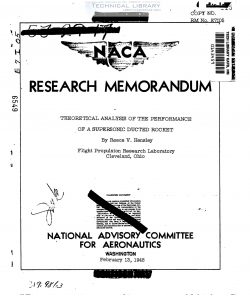naca-rm-e7i05
- Version
- 80 Downloads
- 1.25 MB File Size
- 1 File Count
- April 21, 2017 Create Date
- April 21, 2017 Last Updated
National Advisory Committee for Aeronautics, Research Memorandum - Theoretical Analysis of the Performance of a Supersonic Ducted Rocket

Calculated performance characteristics of a ducted rocket that
uses gasoline and liquid oxygen as the fuel mixture and has a mass
flow of l slug per second are presented. Excess fuel is used to
maintain the rocket combustion temperature within a limiting value
and all this excess fuel is considered to burn in the duct enclosing
the rocket. ‘ Evaluations of net thrust, frontal area, thrust per unit
frontal area, and specific fuel consumption are given for flight
conditions under which such a propulsion system might Operate. An
evaluation is made of the relative thrust increase due to the Jet-
ejector effect of the rocket enclosed in a duct and that due to the
burning of the excess fuel from the rocket exhaust in the duct. The
performances of units with nozzles designed to give exhaust-Jet
expansion to ambient pressure and of units designed to give the
maximum thrust per unit frontal area are given.
At flight Mach numbers of l, 2, and 5 and an altitude of
50,000 feet , thrusts per unit frontal area for the ducted rocket
were of the order of twice those available from a ram Jet. The corres-
ponding specific fuel consumptions were about two to three times those
of a ram Jet, but about one-half to one-third that of the rocket alone.
The thrust increase was due primarily to the burning of the excess fuel
from the rocket inasmuch as only about one-fourth of the total increase
in thrust resulting from the ducting was attributable to the Jet-
ejector effect experienced when the rocket is enclosed in a duct under
these flight conditions. For the same flight conditions, the specific
fuel consumption of the ducted rocket was lower than that of a combina-
tion of equal frontal area consisting of a similar rocket and a ram
Jet operating independently at stoichiometric fuel—air ratio. The net
thrust of the ducted rocket was higher at Mach numbers of 2 and 5, but
lower at a Mach number of 1 than the thrust of the combination at
comparable flight velocities.
| File | Action |
|---|---|
| naca-rm-e7i05 Theoretical Analysis of the Performance of a Supersonic Ducted Rocket.pdf | Download |

Comment On This Post